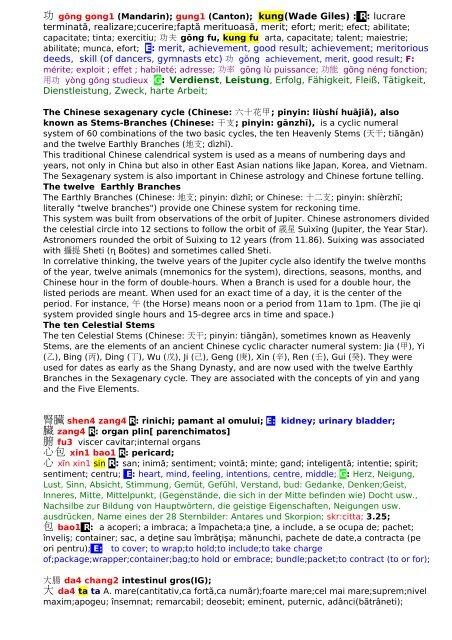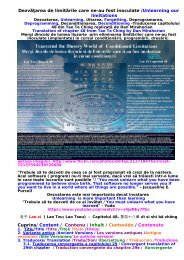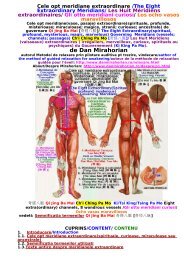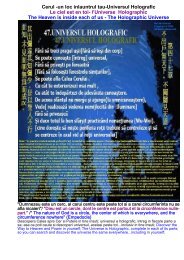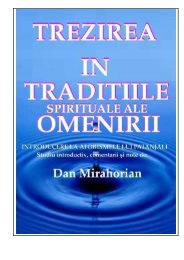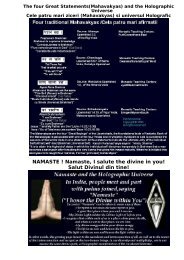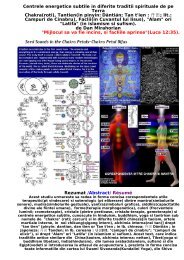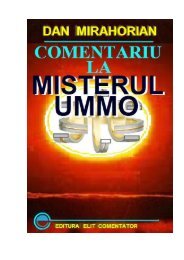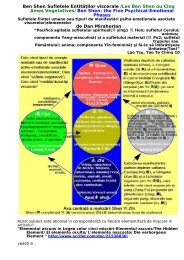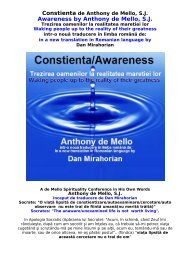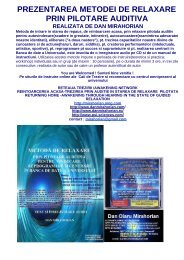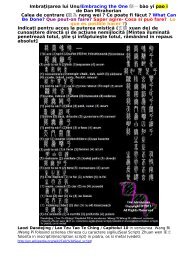äºè¡ææ¯å è¡ ? - Mirahorian
äºè¡ææ¯å è¡ ? - Mirahorian
äºè¡ææ¯å è¡ ? - Mirahorian
Create successful ePaper yourself
Turn your PDF publications into a flip-book with our unique Google optimized e-Paper software.
功 gōng gong1 (Mandarin); gung1 (Canton); kung(Wade Giles) : R: lucrare<br />
terminată, realizare;cucerire;faptă merituoasă, merit; efort; merit; efect; abilitate;<br />
capacitate; tinta; exercitiu; 功 夫 gōng fu, kung fu arta, capacitate; talent; maiestrie;<br />
abilitate; munca, efort; E: merit, achievement, good result; achievement; meritorious<br />
deeds, skill (of dancers, gymnasts etc) 功 gōng achievement, merit, good result; F:<br />
mérite; exploit ; effet ; habileté; adresse; 功 率 gōng lù puissance; 功 能 gōng néng fonction;<br />
用 功 yòng gōng studieux G: Verdienst, Leistung, Erfolg, Fähigkeit, Fleiß, Tätigkeit,<br />
Dienstleistung, Zweck, harte Arbeit;<br />
The Chinese sexagenary cycle (Chinese: 六 十 花 甲 ; pinyin: liùshí huājiǎ), also<br />
known as Stems-Branches (Chinese: 干 支 ; pinyin: gānzhī), is a cyclic numeral<br />
system of 60 combinations of the two basic cycles, the ten Heavenly Stems ( 天 干 ; tiāngān)<br />
and the twelve Earthly Branches ( 地 支 ; dìzhī).<br />
This traditional Chinese calendrical system is used as a means of numbering days and<br />
years, not only in China but also in other East Asian nations like Japan, Korea, and Vietnam.<br />
The Sexagenary system is also important in Chinese astrology and Chinese fortune telling.<br />
The twelve Earthly Branches<br />
The Earthly Branches (Chinese: 地 支 ; pinyin: dìzhī; or Chinese: 十 二 支 ; pinyin: shíèrzhī;<br />
literally "twelve branches") provide one Chinese system for reckoning time.<br />
This system was built from observations of the orbit of Jupiter. Chinese astronomers divided<br />
the celestial circle into 12 sections to follow the orbit of 歳 星 Suìxīng (Jupiter, the Year Star).<br />
Astronomers rounded the orbit of Suixing to 12 years (from 11.86). Suixing was associated<br />
with 攝 提 Sheti (ɳ Boötes) and sometimes called Sheti.<br />
In correlative thinking, the twelve years of the Jupiter cycle also identify the twelve months<br />
of the year, twelve animals (mnemonics for the system), directions, seasons, months, and<br />
Chinese hour in the form of double-hours. When a Branch is used for a double hour, the<br />
listed periods are meant. When used for an exact time of a day, it is the center of the<br />
period. For instance, 午 (the Horse) means noon or a period from 11am to 1pm. (The jie qi<br />
system provided single hours and 15-degree arcs in time and space.)<br />
The ten Celestial Stems<br />
The ten Celestial Stems (Chinese: 天 干 ; pinyin: tiāngān), sometimes known as Heavenly<br />
Stems, are the elements of an ancient Chinese cyclic character numeral system: Jia ( 甲 ), Yi<br />
( 乙 ), Bing ( 丙 ), Ding ( 丁 ), Wu ( 戊 ), Ji ( 己 ), Geng ( 庚 ), Xin ( 辛 ), Ren ( 壬 ), Gui ( 癸 ). They were<br />
used for dates as early as the Shang Dynasty, and are now used with the twelve Earthly<br />
Branches in the Sexagenary cycle. They are associated with the concepts of yin and yang<br />
and the Five Elements.<br />
腎 臟 shen4 zang4 R: rinichi; pamant al omului; E: kidney; urinary bladder;<br />
臟 zang4 R: organ plin[ parenchimatos]<br />
腑 fu3 viscer cavitar;internal organs<br />
心 包 xin1 bao1 R: pericard;<br />
心 xīn xin1 sin R: san; inimă; sentiment; vointă; minte; gand; inteligentă; intentie; spirit;<br />
sentiment; centru; E: heart, mind, feeling, intentions, centre, middle; G: Herz, Neigung,<br />
Lust, Sinn, Absicht, Stimmung, Gemüt, Gefühl, Verstand, bud: Gedanke, Denken;Geist,<br />
Inneres, Mitte, Mittelpunkt, (Gegenstände, die sich in der Mitte befinden wie) Docht usw.,<br />
Nachsilbe zur Bildung von Hauptwörtern, die geistige Eigenschaften, Neigungen usw.<br />
ausdrücken, Name eines der 28 Sternbilder: Antares und Skorpion; skr:citta; 3.25;<br />
包 bao1 R: a acoperi; a imbraca; a împacheta;a ţine, a include, a se ocupa de; pachet;<br />
înveliş; container; sac, a deţine sau îmbrăţişa; mănunchi, pachete de date,a contracta (pe<br />
ori pentru); E: to cover; to wrap;to hold;to include;to take charge<br />
of;package;wrapper;container;bag;to hold or embrace; bundle;packet;to contract (to or for);<br />
大 腸 da4 chang2 intestinul gros(IG);<br />
大 da4 ta ta A. mare(cantitativ,ca fortã,ca numãr);foarte mare;cel mai mare;suprem;nivel<br />
maxim;apogeu; însemnat; remarcabil; deosebit; eminent, puternic, adânci(bãtrâneti);


